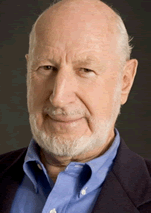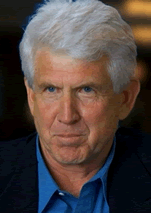2011 Recipients of C&C Prize
Group B

Prof. Norman Abramson Professor Emeritus, University of Hawaii |

Dr. Robert M. Metcalfe Professor of innovation, The University of Texas at Austin |
Citation
For Outstanding Leadership Resulting in the Invention, Standardization, and Commercialization of Internet Packet Access, Beginning with ALOHANET and Then Ethernet
Achievement
Ethernet is the most widely used LAN standard and has had an immense impact on information technology since its initial appearance in the 1980s. Upwards of a billion new Ethernet ports are now shipped annually, counting wireless Ethernet and Wi-Fi. Prof. Norman Abramson and Dr. Robert Metcalfe made significant contributions to the development of the ALOHANET, Ethernet, and related basic LAN technologies.
In 1968, Prof. Abramson moved from Stanford University to the University of Hawaii, where he directed the development of the ALOHANET by an international team of university researchers. The ALOHANET was a wireless data network connecting computer facilities on the Hawaiian islands using a newly developed random access technology, now known as an ALOHA channel. The ALOHA channel used a shared medium access communication method on a UHF wireless network. The shared medium access of the ALOHANET was designed with a simple but effective method for dealing with data packet collisions in the ALOHA channel. That is, when the network hub receives a data packet from a source in the shared channel, the hub sends back an acknowledgement packet to the source in broadcast mode. When the source receives the acknowledgement packet, it can send the next data packet to the hub. If the acknowledgement packet is not received, the source resends the original data packet after a randomly spaced time interval. It was a very simple method for collision avoidance. In addition, it led directly to carrier sense multiple access (CSMA), CSMA/CD (collision detection), and CSMA/CA (collision avoidance), which were later incorporated into various generations of standards for Ethernet and Wi-Fi.
At the end of 1970, the ALOHANET was complete and connected the Hawaiian islands with 9,600-b/s data signals. It was the world’s first wireless packet data network. In 1972, the ALOHANET was connected to the ARPANET in North America using a 56,000-b/s digital satellite channel. In 1973, the first network to utilize random access packet transmission in a satellite channel was put into operation using the NASA ATS-1 satellite in an experimental network that included the University of Hawaii, the NASA Ames Research Center in California, the University of Alaska, Tohoku University in Sendai, the University of Electro-Communications in Tokyo, and the University of Sydney. This network, called PacNet, operated at 9,600 b/s in an ALOHA channel using low-cost satellite earth stations to show the potential of data networks with large numbers of small earth stations.
The ALOHA protocol is part of the data link layer (OSI network layer 2) protocol, which is different from a point-to-point protocol. The ALOHA protocol is today classified as a Medium Access Control (MAC) network protocol using a shared medium. It is based on the arbitration technology connecting plural network terminals first implemented in the ALOHANET. Although the initial ALOHA protocol suffered throughput degradation due to congestion when the traffic increased, this protocol had the merits of simplicity and economy. Later, this protocol was optimized for wired systems and used for Ethernet by Dr. Metcalfe as CSMA/CD.
Ethernet was built upon Prof. Abramson's ALOHANET idea of wireless multiple access using randomized retransmissions and developed further as high-speed CSMA/CD for use in the local-area network, or LAN as it was later called by the IEEE. Early Ethernets were able to run much faster than the ALOHANET because they transmitted on copper cables instead of wirelessly. Decades later, Ethernet moved back to wireless and today again looks much like the ALOHANET, known as Wi-Fi. Ethernet in its many forms has now become the packet plumbing of the Internet.
While pursuing a doctorate in computer science at Harvard University, Dr. Metcalfe worked on MIT Project MAC (1970-1972) and then at the Xerox Palo Alto Research Center (PARC) in 1972, where he developed a coaxial cable LAN system. At that time, the Alto, perhaps the first modern personal computer, was under development at PARC, and Dr. Metcalfe was a team leader for networking Altos to an early laser printer and to the fledgling Internet. Dr. Metcalfe invented the networking system initially called the Alto ALOHANET, wherein participating stations would inject their packets of data, traveling at Mbps on coaxial cable. In addition, as in the ALOHANET, there would be collisions in Alto ALOHANET requiring retransmissions. Ethernet randomized retransmission as in the ALOHANET, but improved packet throughputs under load with carrier sense and collision detection?carrier sense multi access with collision detection, or CSMA/CD. As for papers, Dr. Metcalfe, with David Boggs, published “Ethernet: Distributed Packet-Switching for Local Computer Networks” in the Communications of the ACM in 1976.
Dr. Metcalfe put in an effort to encourage Xerox to freely license its Ethernet patents and to cooperate with Intel and DEC to create a standard LAN system through the IEEE. As a result, 10 Mbps Ethernet was submitted for the new IEEE Project 802 in 1980. Many corporations took part in the open Ethernet standard. IEEE subsequently standardized IEEE802.3 CSMA/CD in 1982. Afterwards, the 10-Mbps 10BASE-T Ethernet finally established its position as the global LAN standard.
Ethernet has been widely used in offices, factories, schools, and homes, increasing its bit rate over the years from 10 Mbps to 100 Mbps, 1 Gbps, 10 Gbps, and recently 40 Gbps and 100 Gbps. Ethernet is continuing to play an extremely important role in information technology today.
The ALOHANET protocol adapted for the CSMA/CD Ethernet has had a significant impact on the use, progress, and dissemination of information technology since the 1970s. The NEC C&C Foundation thus highly praised Prof. Abramson and Dr. Metcalfe for their contributions to the advancement of the information technology industry, education, research, and the improvement of our lives.
